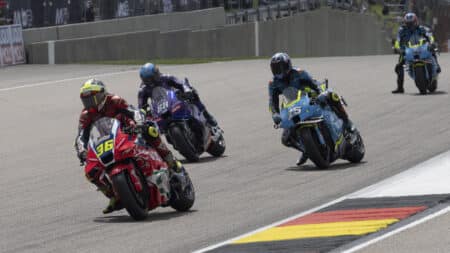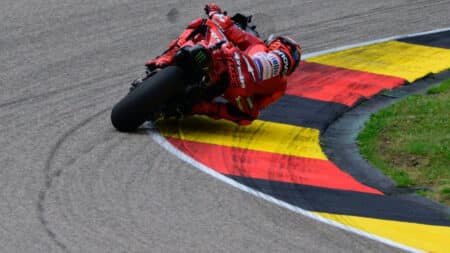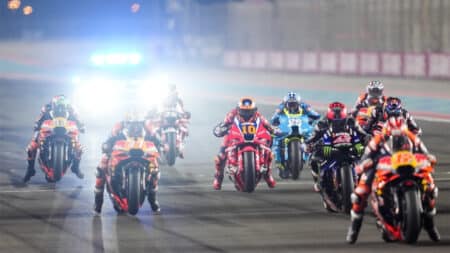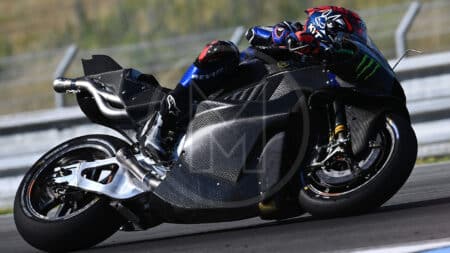It’s not easy finding out much about a rider in the 15-minute interview slots that are the norm in MotoGP now. Unless something interesting happens.
On one of the first occasions I interviewed Jorge Lorenzo, our brief time together was blighted by a malfunctioning automatic door. We were sat right by the door in the lounge area of Yamaha’s hospitality truck, with team staff coming and going as we chatted.

At first the door obediently swooshed open and shut like we were on the Starship Enterprise, but then it developed a fault, and each time it jammed Lorenzo became more infuriated, until I was certain I could see steam coming out of his ears.

And all this while we discussed his interest in finding inner peace through meditation, specifically through sophrology, which devotees use to improve concentration and motivation via mental and muscle relaxation.
As you will have gathered from the door incident and from the occasional tantrums he throws inside his helmet, Lorenzo has good reasons to have such interests. He is one of those riders who always simmers on the inside, like a volcano about to erupt. There have been plenty like that, including five-time 500 world champion Mick Doohan, who mastered the extraordinarily difficult trick of containing that energy until he could put it to better use aboard a motorcycle.
Doohan never meditated in the strict meaning of the word (he was as likely to take up meditation as he was vegetarianism) but he found his own way of achieving a degree of focus that allowed him to perform to 99.99 per cent of his ability each time he exited the pitlane. Very, very few sportsmen get close to that consistency of peak performance.
Psychologists call this elusive mental state ‘flow’, though you may know it better as being in the zone. According to Wikipedia, flow is the ‘mental state of operation in which a person performing an activity is fully immersed in a feeling of energized focus. It represents perhaps the ultimate experience in harnessing the emotions in the service of performing’.

Unlike Doohan, Lorenzo sometimes enters the zone and sometimes doesn’t, which is why his career has been a bit up and down, and why he has tried to fix this problem by saying Om at least once a day. This year, just like last, it took him several races to find his way into the zone.
Last season he scored one podium from the first five races; this season he started with three gloomy finishes outside the top three, followed by three rampant victories; almost like he had flicked a switch inside. Since the lights went out at Jerez a month ago he hasn’t been overtaken once – that’s 78 consecutive laps in the lead.
Being in front is where Lorenzo’s mind likes to be. Unlike some riders he goes better on an empty racetrack. The presence of rivals to his left and right trying to go faster than him doesn’t stir him to greater effort, it merely disturbs his wish for Zen-like inner calm. “When I’m in sixth place it’s not the same, I struggle to be smooth,” he said last year.
Of course, it’s not all in the mind. Machinery also matters. Last year the Yamaha wasn’t as good as the Honda, even if it was a friendlier motorcycle. This year the M1 is still easygoing, and much better, thanks largely to the fully seamless gearbox that suits Lorenzo even more than it suits his team-mate.
Lorenzo is all about smoothness in his riding technique and serenity in his racing brain, so the smoother corner entry enabled by seamless downshifting is a huge boost for him and has allowed him to fix the one area in which he lagged behind Valentino Rossi: braking.

Lorenzo’s genius is a very different kind to that displayed by Márquez. His progress is smooth and unruffled, so even when he’s faster than Márquez he looks slower; just as glass-smooth Eddie Lawson did against Wayne Gardner. Some years ago Lawson told me, “people used to say ‘boy, you look slow out there’ and I took that as a complement. If I won and looked slow, what did that say about the other guys?”
Now that Lorenzo’s bike is right, he is fully in the zone, riding superbly and his rivals have got problems, he is going to take a lot of stopping.
Certainly, Rossi can say goodbye to a tenth world title unless he can sort out his Saturdays. More often than not he’s the Sunday hero, charging through the pack towards the podium, but that’s not going to win him the championship. Somehow he needs to find a way of distilling those 45 minutes of Sunday heroism into a minute or two on Saturday afternoon, so he doesn’t end buried deep in the grid
But Rossi has had the problem of producing scintillating one-off laps for many years and it’s been exacerbated by the 15-minute qualifying format. Although he has long been the master of reinvention, this seems to be the one difficulty he cannot surmount. Who knows, he may yet, but he better get a move on.
This time last year I wrote about how riders are affected by upward and downward spirals of self-confidence. At that time it was Lorenzo who was on the way down, while the only way was up for Marc Márquez. Incredibly, the pair now find themselves in exactly opposite situations: while Lorenzo floats forward on a wave of self-confidence, Márquez digs himself an ever-deeper hole.

Lorenzo has been there so he knows how it works. “When everything is right you ride better and you feel safer,” he told me earlier this year. “When you have difficulties you ride more tense, so you ride worse.”
Márquez’s difficulty is a Honda that doesn’t do what he wants it to do. Since the world champion is their prize asset, HRC will do whatever it takes to make him even faster. Since last year they’ve been working hard to give him an engine, chassis and electronics package that would precisely suit his way-out riding style. But somehow they’ve made a bike less suited to his technique. Honda would have got away with it, except for the fact that Yamaha and Ducati have found a huge amount of pace.
At the first six races of 2015 Honda’s top finisher was an average 1.6sec slower over race distance compared to last year, while the best Yamaha was 11.06sec faster and the best Ducati 17.8sec faster.
Race development is a never-ending road, and sometimes you take a wrong turning. After several years of dominance, that’s what HRC seems to have done. (Don’t forget that Honda would almost certainly have won the last four MotoGP titles if it hadn’t been snookered by a change of front-tyre allocation midway through 2012).

Instead of allowing Márquez to ride faster and looser, the 2015 RC213V won’t let him ride loose or fast. Both the stubby, aggressive RCV and its number-one rider exist on a knife edge and they’ve slipped off that knife edge. The problem obviously isn’t simple to solve — it’s not merely the engine, the chassis or the electronics, it’s a combination of all three.
At Mugello the youngster consistently ran wide in the corners, most noticeably at turn one, and indeed it was this issue that was his downfall. With six laps to go he ran wide through turn two, which put him on the wrong line for turn three, which forced him to lean further than usual, with inevitable consequences.
Márquez rides the front harder than anyone, but a combination of engine character, chassis balance and electronics is throwing too much load onto the front during corner entry, especially once rear grip diminishes. And when the rear loses load it doesn’t kick sideways like last year, it snaps sideways; too violently even for Márquez to control. That’s exactly how the RCV behaved in the early days of the 800s.
Earlier this year he also struggled on corner exits, but HRC have already fixed that problem. Now they are burning the midnight oil at their Asaka HQ as they race to fix the corner-entry problem in time for his home Grand Prix at Catalunya. It may turn out to be too late to rescue the championship — he may need a ten-in-a-row performance like last year to do that — but it’s going to be fun watching him try.











